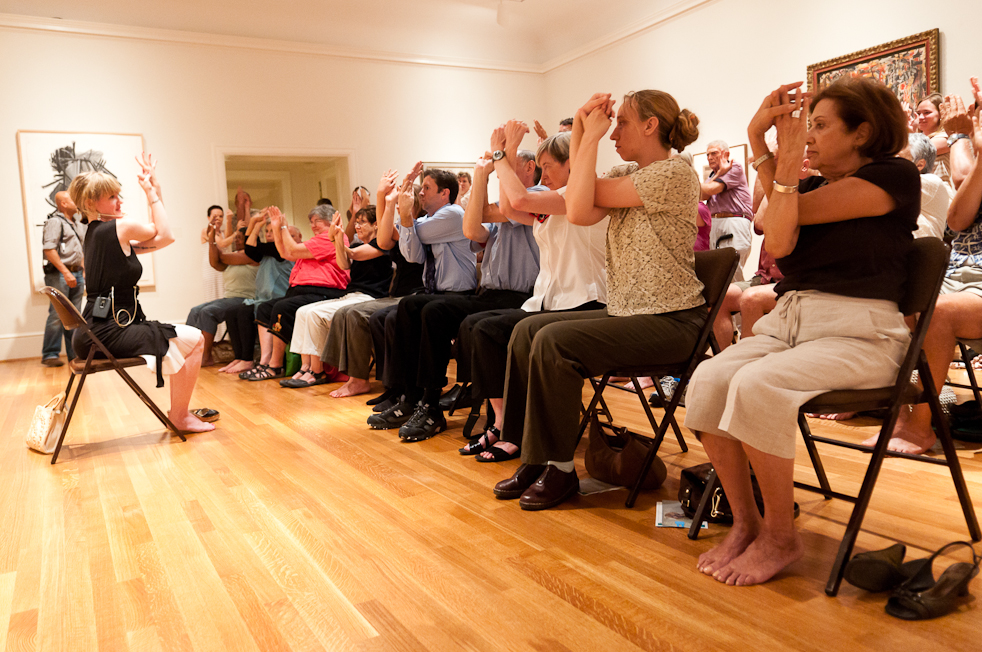
Chair Yoga: Maintaining Your Comfort Zone
Photo Credit: Vincent Gallegos, via Flickr Creative Commons
Yoga asks us to meet ourselves right where we are. When we do this, we honor ourselves in the deepest way. We give up the notion that we should be somewhere different than we are and we accept “what is” without wishing or wanting things to be different.
Yoga is not dependent on how much we move, but how much attention we are developing as we move
Sometimes this means we need to align with the energy of the pose without forcing ourselves into a form that doesn’t suit us. If we push or pull during yoga in an effort to get into a posture and ignore signs of pain or discomfort, our body can suffer. If this effort causes us to hold our breath, our nervous system can suffer.
In order to stay true to our own needs during our yoga postures, we may need more support than just a small tweak here or there. Many Ornish Lifestyle Medicine (Intensive Cardiac Rehabilitation) participants find these adjustments by doing yoga in a chair. Chair yoga offers many more options for staying within your comfort zone and getting the most from your practice.
Subtle Movements to Manage Stress
When we use yoga for managing stress, the goal is to quiet the nervous system and the mind. So using a chair is not just a practice for those with injuries or mobility issues; it’s a route to more quiet and subtle movements in order to shift our attention inward and release any tensions we have stored.
These movements can improve flexibility and articulate the joints, but most important it offers us the opportunity to listen to our body’s signals. With subtle refinement we start to become aware of the language of our own body. Yoga is not dependent on how much we move, but how much attention we are developing as we move.
How to Use a Chair to Adapt Some Common Poses
You can also listen to this One-Hour Chair Practice.
Cobra
- Sitting in a chair, gently hold the sides of the chair with both hands.
- On an exhale breath, slowly lower the chin to the chest, allowing the spine to gently round. As you inhale, start to lift the nose toward the ceiling and allow the back to lengthen and even arch slightly. Allow the shoulders to roll back and down naturally. If there is pain in the neck lower the chin slightly. Keep the breath moving.
- This can be repeated 3 to 5 times or held with a steady smooth breath.
- Return to a neutral position when complete.
Spinal Twist
- As you sit in the chair, cross the right leg over the left. If that isn’t easy you can just leave both feet on the floor.
- Now place the left hand on the right knee and use the right hand to grab the chair right below you.
- On the inhale breath, find your inner lift and as you exhale begin to rotate from the tail up through the vertebrae of the neck. Keep the breath smooth and even.
- See if you can find a little bit of movement in a lot of places rather than a lot of movement in one place. Even the eyes can gaze gently to the back corners. Soften the areas that aren’t necessary for the twist.
- This can be done by coming in and out 2 to 3 times or you can enjoy holding for a few breaths and coming out on an exhale breath when ready.
Forward Bend
- From your seated position, allow your feet to separate slightly. Soles on the feet firmly planted on the floor.
- Lean forward from the pelvis and fold your forearms on the thighs. You could even tuck a folded bed pillow against your abdomen for more support.
- Allow the spine to gently round and the head to come forward with the chin resting toward the chest. Take a few breaths and soften the back of the heart. As if your heart were breathing.
- To come out, use the support of the arms to press and roll up.
Be Creative
So many postures can be adapted to sitting in a chair. Think about how you could adapt each one of the poses so they are enjoyable and supportive for your body. Also, ask your yoga teacher for suggestions. Let yourself experience your yoga practice as a time to connect with yourself just where you are.
Our lives often deliver us into chaotic movement patterns and a sense of constant motion. Using a chair for practice shifts us out of that constant need to move. It delivers us to a practice that helps us to realign and reboot ourselves, a practice of honoring subtleties and stillness.
How has practicing yoga in a chair helped you to better listen to the subtleties of your body?








